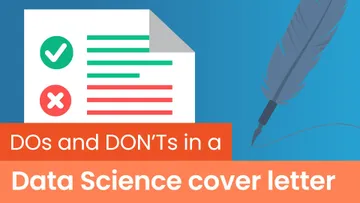When you format a data science cover letter, there are 6 keys to success:
- unified look with your resume;
- easy-to-read font;
- single-page length;
- consistent spacing;
- 1-inch-margins and left alignment;
- compatible file type.
Why is the format of a data science cover letter important?
The format of your data science cover letter is critical to making a positive first impression. A clean and polished format keeps the focus on the content and conveys attention to detail.
Conversely, a sloppy layout signals a lack of professionalism and can instantly eliminate you from the race for your dream job or prestigious internship.
So, how to format a data science cover letter for the win?
Let’s go through them together.
Match your data science resume style
Using the same style in both your cover letter and your data science resume will give your job application a cohesive and elegant look. Also, make sure you align both with the image of the employer. A conservative company won’t appreciate ornate fonts and extravagant design. Keep in mind that your cover letter is also a business letter; and, above all, a powerful tool to get a data science interview invitation. So, its style should reflect that.
Choose a crisp font
With so many font styles out there, choosing the best one could be a challenge.
Our advice is: Keep it simple and clean. Yes, when you format a data science cover letter, legibility is a top priority.
Flashy custom fonts and special characters are not only distracting, but they’re also hard to read, both for Applicant Tracking Systems (ATS) and humans. There’s nothing wrong with classics like Calibri, Verdana, and Cambria (among many others). Another way to ensure your data science cover letter is readable and scanner-friendly is to select the right font size. Stay on the safe side and go for 10-12 pt. That’s how you’ll tick two boxes: easy-to-read and easy-on-the-eyes.
Cut down the length
Less is more. A single one-sided page with 250-400 words is completely adequate for an efficient cover letter. Resist the temptation and leave out any details that the hiring manager can find on your resume. Of course, you can be brave and experiment with a super-concise cover letter of 150 words. But while this one is sure to be read, you run the risk of omitting some important information.
Remember that spacing is important, too
When it comes to spacing, consistency is key. To achieve a coherent look, opt for single-line spacing after each section of your data science cover letter (contact information, greeting, introduction, body, closing, and sign-off). Remember, packing your cover letter with quality content doesn’t equal typing one giant wall of text. That would make it look cramped and messy. On the other hand, spacing and shorter paragraphs balance the page and let your document breathe. Plus, they make the content much easier to process.
It’s okay to adjust the margins… But keep the alignment to the left
But don’t go lower than ¾ or ½ inch… And only if you really need the extra space. When you format a data science cover letter, you need to make sure it doesn’t end up looking cluttered and squished. In other words, it’s best to stick to the business letter format rules and set 1-inch margins on all sides. That leaves plenty of margin space for printing and creates an elegant layout. Speaking of best practices, always left-align your cover letter content. No justification and indentation needed, as they go against the standards.
Save as… the appropriate file type
Saving your data science cover letter in the right file format is vital.
To make sure the reader can open and view it, rely on text type formats, such as .doc or pdf. Both are widely accepted and usually cause no compatibility issues.
How to format a data science cover letter: Additional resources
If you need help to format a data science cover letter, you can browse the wide choice of cover letter builders available online. But how do you pick the best out of many? To make your search easier, we’ve made a quick list of the cover letter builders that offer the best features and useful relevant resources.
Your data science cover letter is an effective tool in your job application process. Now that you know how to format it to make a strong first impression, be sure to check out the rest of our articles on the topic:
- How to Write a Data Science Cover Letter
- How to Organize a Data Science Cover Letter
- Data Science Cover Letter Dos and Don’ts
If you’re eager to lift the curtain and see what the data science interview has in store for you, check out our in-depth guide Data Science Interview Questions and Answers You Need to Know and take our course on Starting a Career in Data Science: Project Portfolio, Resume, and Interview Process.
Ready to take the next step towards a data science career?
Check out the complete Data Science Program today. Start with the fundamentals with our Statistics, Maths, and Excel courses. Build up a step-by-step experience with SQL, Python, R, Power BI, and Tableau. And upgrade your skillset with Machine Learning, Deep Learning, Credit Risk Modeling, Time Series Analysis, and Customer Analytics in Python. Still not sure you want to turn your interest in data science into a career? You can explore the curriculum or sign up for 12 hours of beginner to advanced video content for free by clicking on the button below.




